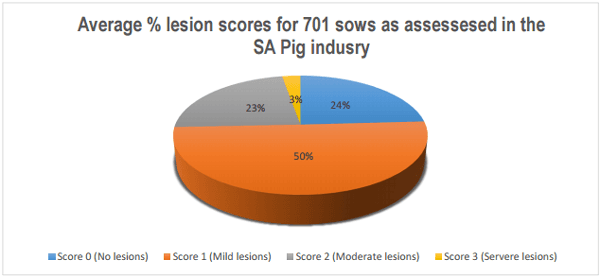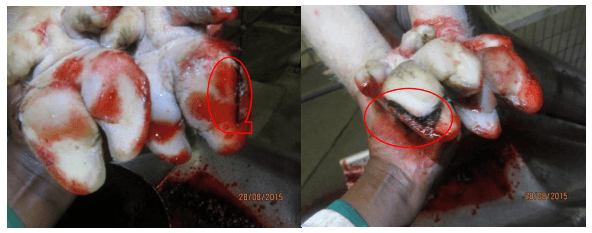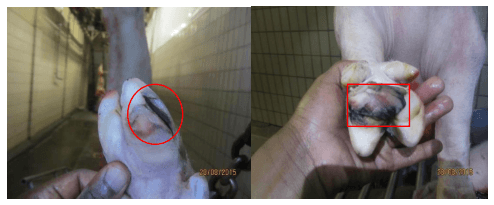Sow lameness overview in the South African pig industry
Published: September 30, 2016
By: Mashilo Phosa / Chemuniqué RSA, e-mail: mashilo@chemunique.co.za.
The South African pig industry is no different from other pig industry in the world with regard to sow lameness. More than 76% of the sows assessed for lesion scoring had a lesion in more than one claw, which in turn can lead to high prevalence of lameness depending on the severity of the lesions. Of the 701 sows assessed at the different abattoirs, sows within score 1 were 51% and with increasing severity lesion i.e. score 2&3 having, 26% of the sows were within this range.
“Sow health: lameness is not just a cow issues – the swine industry has placed less emphasis on lameness and has conducted less research into the management and prevention of lameness in sows. It is likely that the effect of lameness in the reproductive swine herd has been underestimated” (Nutrition & Health: Swine)
It is estimated that sow lameness prevalence typically ranges from 6% on excellent farms up to 25 to 30% in problem herds. As a result, lameness causes millions of rand in losses to pig producers through lost productivity. Lameness prevention is particularly important for young sows, as they will be the most productive animals in the herd if lameness can be prevented.

The diagram above illustrate the interaction and complexity of lameness and factors contributing to sow lameness, the above are the major lameness factors and therefore in dealing with sow lameness, one has to take more than of the above factors into consideration, as lameness is a multi-factorial problem within the swine industry.

Method of assessment on the above lesion scores, was adapted from the Feet First programme (Zinpro Performance Minerals) and lesion scoring guide/system was used as a tool, and among others, the Feet First programme also developed locomotion scoring tool as well as the sow lameness cost calculator.
From the above figure, it clearly indicates that with sows assessed for lesion scoring in South African abattoirs, 76% of the sows had lesions and most of the sows assessed on the claws/hooves had more than 90% lesions with the individual parameters measured. In other study in different countries, more than 90% of all sows had a lesion in the wall and heel and about 50 – 75% of the sows had overgrown heels, lesions in the white line, heel/sole junction and sole. Heel lesions and overgrown heels were more prevalent in rear feet.

The lesions of greatest concern are those that penetrate the horn wall into the corium of the foot and cause an inflammatory response, such as sidewall cracks of the outer horn wall or white line lesions. Inflammation is often accompanied by pain and is one of the most apparent consequences of lameness. Many times lame sows are thin and have poor body condition. Sows with chronic lameness frequently have decreased feed intake, which tends to impact reproductive performance. Inflammation also causes changes within the body, disrupting how nutrients are utilized and even impacting ovulation.

Lameness can be caused by nutritional problems, management and environmental and genetic factors. Flooring type and housing (crates vs. groups) make a difference. Rough, concrete slats can damage hooves and tear off dew claws or horn wall capsules, for example. Some of the most common problems leading to lameness have been reported for sows with elongated claws, claw cracks, heel erosion and overgrown heels. Uneven toes can also significantly impact the incidence of lameness.

Research is currently looking at on-farm solutions to help prevent lameness and improve welfare related foot problems. Some producers worldwide, has sows walking through foot baths containing copper sulfate, although some experts days sows are not walked through foot baths frequently enough to make a significant difference. In addition to the foot baths, some producers apply antibacterial sprays to feet and legs, however, most interestingly some research has shown trace mineral mixes containing complexed zinc, manganese and copper can also help improve sow claw health while helping contribute to the welfare of the sows.
Related topics:
Authors:
Chemuniqué
Recommend
Comment
Share
7 de octubre de 2016
Largely we out to open this prime finds to many of our farmers through out Africa.
Recommend
Reply

Would you like to discuss another topic? Create a new post to engage with experts in the community.








